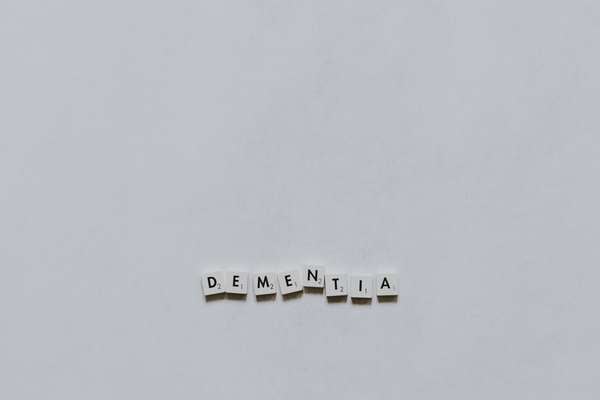
When Rob McFadden wakes at 3am with his heart racing and sweat pouring down his face, the terrifying dream feels utterly real. In his mind, someone was just trying to stab him—the last image burned into his memory is a woman with scissors inches from his face.
For this charming Sydney grandfather of eleven, these disturbing nightmares are among the most distressing symptoms of his Lewy body dementia diagnosis.
But Rob's willingness to share his raw, honest experience sheds light on a condition affecting far more Australians than many realise.
In 2025, there are an estimated 433,300 people living with all forms of dementia in Australia—more than four times the outdated figures often quoted. This number is projected to increase to an estimated 812,500 by 2054 with a projected percentage change of 88 per cent, making dementia one of our most pressing health challenges.
'Most of the time for me, some b*******'s trying to kill me, which is disconcerting because it's so vivid you actually think you're awake'
A successful life suddenly derailed
Rob's journey with dementia began at just 57, when neurological issues forced him to retire from a successful marketing career almost overnight. After studying psychology at university, he'd built a thriving career while raising eight children with his wife Carol.
'I developed some neurological issues that took me from having a large number of people report to me overnight to being retired, which was a bit of a shock to the system,' the now 70-year-old recalls.
Initially, Rob attributed his headaches to the stress of long work hours and coming home to a house full of noisy children. But warning signs began mounting. After a nearly spotless driving record, he clipped a bollard on his way to work, then couldn't navigate to his boss's office despite having a clear line of sight through glass windows.
The most frightening symptom was yet to come. Rob developed such severe balance problems and nausea that he had to crawl from his bedroom to the bathroom with his eyes closed. Some of these episodes he kept from Carol, not wanting to add to her worry while she was working.
The long road to diagnosis
Despite these dramatic symptoms forcing his early retirement, it took a staggering ten years for Rob's dementia to be officially diagnosed. A battery of tests revealed significant grey matter loss in his brain for his age, leading to his Lewy body dementia diagnosis.
More than 100,000 Australians have this type of dementia, according to Dementia Australia, making it one of the more common forms after Alzheimer's disease. The condition is characterised by abnormal protein deposits in the brain that affect thinking, movement, behaviour, and mood.
Rob admits he was initially 'stunned' by the diagnosis—feeling too young and overwhelmed by the reality that there's no cure.
Living with hallucinations and disturbing dreams
One of Lewy body dementia's distinctive symptoms is hallucinations, which initially 'freaked out' Rob, though he's learned to manage them with his characteristic humour.
'You see people in the room who aren't clearly defined, but they're people. They don't have a definitive face in terms of nose and eyebrows, but they've got a face and they've got a body and arms and legs. They don't do anything. They don't chase me. They just stand there,' he explains.
Rob also experiences auditory hallucinations, though nothing sinister. 'I do hear voices—whenever I tell people that, they always back away a little bit. I don't hear the devil wants you to kill everybody in the room. What I hear, it's almost like people are in another room talking and you pick up some words in the conversation, and then they're really quite dull.'
But it's the dreams that truly disturb him. The vivid nightmares typically strike around 3am, often featuring someone trying to harm him. The dreams are so realistic that he believes he's awake, mimicking his actual bedroom in terrifying detail.
'Occasionally I'm up here watching mindless TV at three o'clock in the morning trying to numb my brain and go back to bed,' he shares.
Understanding Lewy body dementia symptoms
Lewy body dementia causes a range of symptoms that can vary significantly between individuals:
• Visual hallucinations (often well-formed people or animals)
• Sleep disturbances including vivid dreams and acting out during sleep
• Movement problems similar to Parkinson's disease
• Fluctuating attention and alertness
• Memory problems that may be less severe than in Alzheimer's disease initially
• Changes in automatic body functions like blood pressure and temperature control
Coping with humour and family support
Rob has developed a dark sense of humour about his condition, referring to 'his mate Lewy' and sharing relevant memes with his eight children and eleven grandchildren, aged between three and 21.
'Like I send them little reels like, don't you hate it when the voices in your head are arguing and then they lose their place and you have to start all over again? That's relevant to me and they laugh. I don't know whether on the inside they groan, but they share the humour with me.'
This approach helps combat isolation, which Rob identifies as 'just a killer' for people with dementia.
The daily challenges
While Rob no longer needs to crawl to the bathroom, he still faces daily obstacles. He has what he calls a 'tenuous relationship' with walls and doors, frequently misjudging distances and collecting bruises from walking into table edges or door frames.
His memory has become 'fuzzy' - he might put food in the fridge instead of the microwave to heat it up, or struggle with word selection. Concentration is particularly draining, both mentally and physically.
Rob has also developed new compulsions, much to Carol's amusement. 'I hate seeing any kind of crumb or stain on the kitchen bench, like a rim from a coffee cup. Quite a few times a day I'm in there with my cloth and there might be a small bit of fluff on the floor or something... I can't not pick it up whereas 10 years ago, I could have walked past it for a month.'
The impact on loved ones
For Carol, Rob's wife of more than 30 years, the changes began subtly. She noticed him pouting his bottom lip, staring into space, and losing his naturally affectionate nature—no longer touching her arm as he walked past or giving her cuddles while she stood at the sink.
'He has always been a very affectionate and loving man and this was out of character for him,' she noted. She also observed him drifting into dazes and having 'explosive episodes if something didn't go right' - uncharacteristic for someone who'd always been calm.
When Rob received his diagnosis, Carol found it devastating, particularly a letter suggesting he should 'get his affairs in order,' which added to their shock.
'I'm not really trying to think too far into the future. In some way that's denial... I don't want him to ever have to go into care. I'm a bit emotional about that,' Carol says, her voice breaking.
Australia's growing dementia challenge
Rob and Carol's story reflects a much larger Australian reality. In 2023, dementia was the second leading cause of death in Australia, and the leading cause of death among Australian women.
An estimated 1.7 million people in Australia are involved in the care of someone living with dementia, highlighting the enormous impact on families and communities. The bulk of care is provided by informal carers, with informal care being the only care received for many activities—for example, 89.2 per cent of people needing help with reading and writing receive only informal assistance.
The hope for prevention and early action
While there's currently no cure for dementia, research offers encouraging news about prevention. Globally, it is estimated that 45 per cent of dementia cases could be delayed or avoided by addressing risk factors throughout life.
The most preventable form of dementia is vascular dementia, which can be prevented by minimising risk factors for stroke and other conditions that damage blood vessels and reduce circulation.
Actions that may help reduce dementia risk
- Stay physically active throughout life
- Maintain social connections and mental stimulation
- Protect hearing and vision
- Manage blood pressure, diabetes, and cholesterol
- Don't smoke and limit alcohol consumption
- Maintain a healthy weight, especially in midlife
- Reduce exposure to air pollution where possible
New national action plan provides hope
Australia has recognised the urgency of addressing dementia with the National Dementia Action Plan 2024-2034, Australia's national dementia policy framework that aims to improve the lives and care of people living with dementia, their carers and families over the next 10 years.
The first framework is expected to be released in mid-2025, providing concrete steps for better support and services.
Breaking down the stigma
Rob emphasises that a dementia diagnosis isn't the end of meaningful life. 'If I tell somebody I've got dementia, they kind of look at me a bit weird. You're not confused, you're not lost, you're not struggling or telling me the same story over and over again. All those things that most people are judged to be the markers of dementia.'
He points out that dementia encompasses much more than memory loss—the hallucinations, depression, anxiety, and other symptoms that people don't always recognise.
'Sometimes there's discrimination against people who have dementia and they're not doing anything deliberately to upset you. Their behaviour might not suit you, but I guess people don't know what to say. Just acknowledge the reality and say that sucks.'
Carol echoes this sentiment, urging Australians to be more empathetic: 'Just to treat the person the same as you always have, as hard as that might be.'
Getting help and support
For Australians concerned about dementia symptoms in themselves or loved ones, several resources are available:
- Dementia Australia National Helpline: 1800 100 500
- GP consultation for memory concerns and cognitive testing
- Dementia Australia website:
www.dementia.org.au
for information and local services
- Carer Gateway: 1800 422 737 for carer support services
Carol's advice to other Australians is clear: 'I'd like to urge people to get tested early if they think there might be some cognitive changes. Whilst the long-term outcome might not change, there are some drugs and methods that may delay the decline.'
A message of resilience
Despite the challenges, Rob and Carol continue living what they describe as a 'happy, normal life.' Their story reminds us that while dementia brings difficulties, it doesn't have to end meaningful relationships, humour, or hope.
As Carol reflects, dementia involves 'a long grieving period for both the person with the dementia and their loved ones,' but their experience shows that love, support, and understanding can help families navigate this difficult journey together.
Rob's courage in sharing his story helps break down the barriers of misunderstanding around dementia, showing that people living with the condition are still very much themselves—deserving of respect, support, and the same human connections we all need.
Have you or your family been affected by dementia? We'd love to hear about your experiences and what support has been most helpful in the comments below.
Original Article
https://www.news.com.au/lifestyle/h...299a95fa796063cd104c200ce6e084?from=rss-basic
Dementia facts and figures | Dementia Australia
Cited text: In 2025 there are an estimated 433,300 people living with all forms of dementia in Australia.
Excerpt: In 2025, there are an estimated 433,300 people living with all forms of dementia in Australia
https://www.dementia.org.au/about-dementia/dementia-facts-and-figures
Dementia facts and figures | Dementia Australia
Cited text: Dementia is the leading cause of death for Australian women.3 · In 2025 there are an estimated 433,300 Australians living with dementia.
Excerpt: In 2025, there are an estimated 433,300 people living with all forms of dementia in Australia
https://www.dementia.org.au/about-dementia/dementia-facts-and-figures
Dementia facts and figures | Dementia Australia
Cited text: This figure is projected to increase to an estimated 812,500 by 2054 with a projected percentage change of 88 per cent.
Excerpt: This number is projected to increase to an estimated 812,500 by 2054 with a projected percentage change of 88 per cent
https://www.dementia.org.au/about-dementia/dementia-facts-and-figures
About dementia | Australian Government Department of Health, Disability and Ageing
Cited text: In 2023, dementia was the second leading cause of death in Australia, and the leading cause of death among Australian women.
Excerpt: In 2023, dementia was the second leading cause of death in Australia, and the leading cause of death among Australian women
https://www.health.gov.au/topics/dementia/about-dementia
Dementia facts and figures | Dementia Australia
Cited text: This can include people in their 30s, 40s and 50s.5 · An estimated 1.7 million people in Australia are involved in the care of someone living with dem...
Excerpt: An estimated 1.7 million people in Australia are involved in the care of someone living with dementia
https://www.dementia.org.au/about-dementia/dementia-facts-and-figures
Dementia in Australia | Australian Bureau of Statistics
Cited text: Notably, the bulk of care was provided by informal carers (relatives or friends), with informal care being the only care received for many of the acti...
Excerpt: The bulk of care is provided by informal carers, with informal care being the only care received for many activities—for example, 89.2 per cent of people needing help with reading and writing receive only informal assistance
https://www.abs.gov.au/articles/dementia-australia
Dementia in Australia | Australian Bureau of Statistics
Cited text: Similarly, of those needing assistance with meal preparation, this need was only met by informal sources for 81.1 per cent of the people affected.
Excerpt: The bulk of care is provided by informal carers, with informal care being the only care received for many activities—for example, 89.2 per cent of people needing help with reading and writing receive only informal assistance
https://www.abs.gov.au/articles/dementia-australia
About dementia | Australian Government Department of Health, Disability and Ageing
Cited text: Globally, it is estimated that 45 per cent of dementia cases could be delayed or avoided by addressing these risk factors where possible (Dementia prevention,...
Excerpt: Globally, it is estimated that 45 per cent of dementia cases could be delayed or avoided by addressing risk factors
https://www.health.gov.au/topics/dementia/about-dementia
About dementia | Australian Government Department of Health, Disability and Ageing
Cited text: The most preventable form of dementia is vascular dementia. This type of dementia can be prevented by minimising risk factors for stroke and other con...
Excerpt: The most preventable form of dementia is vascular dementia, which can be prevented by minimising risk factors for stroke and other conditions that damage blood vessels and reduce circulation
https://www.health.gov.au/topics/dementia/about-dementia
National Dementia Action Plan 2024—2034 | Australian Government Department of Health, Disability and Ageing
Cited text: The National Dementia Action Plan 2024—2034 (the Action Plan) is Australia’s national dementia policy framework. It aims to improve the lives and care...
Excerpt: the National Dementia Action Plan 2024-2034, Australia's national dementia policy framework that aims to improve the lives and care of people living with dementia, their carers and families over the next 10 years
https://www.health.gov.au/our-work/national-dementia-action-plan
National Dementia Action Plan 2024—2034 | Australian Government Department of Health, Disability and Ageing
Cited text: The first framework is expected to be released in mid-2025.
Excerpt: The first framework is expected to be released in mid-2025
https://www.health.gov.au/our-work/national-dementia-action-plan







